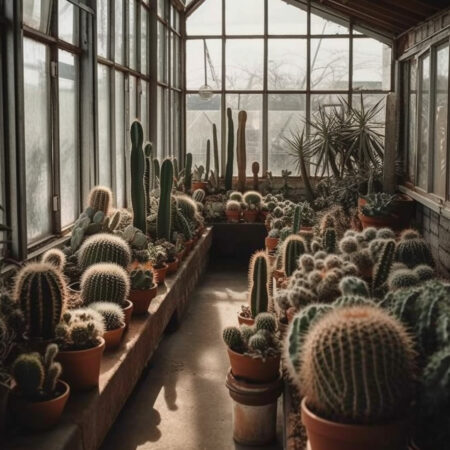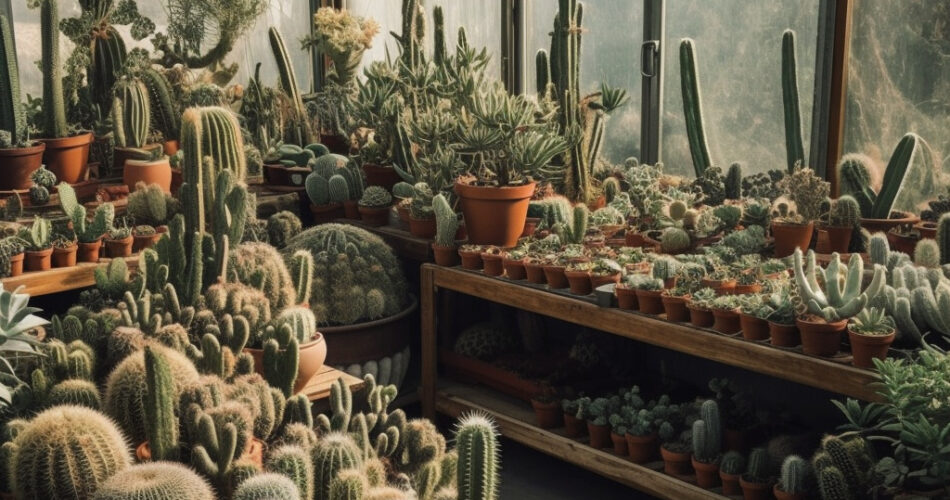Key Takeaways:
- Air circulation is crucial for the health and growth of indoor cacti.
- Proper air circulation facilitates photosynthesis, respiration, and temperature regulation.
- Poor air circulation can lead to root rot, dust buildup, excessive humidity, and fungal diseases.
- Optimal air circulation enhances cacti growth and nutrient translocation.
- Choose a well-lit location with ample sunlight for your cacti and avoid areas with poor air circulation.
- Use ventilation techniques like opening windows, using oscillating fans, and exhaust fans to optimize airflow.
- Fans and air purifiers can improve air circulation in the growing area.
- Consider humidity levels, temperature range, and air quality as factors affecting air circulation.
- Clean cacti regularly to remove dust and debris, avoid smoking indoors, and consider adding air-purifying plants.
- Rectify poor airflow spots, prevent excessive or insufficient air circulation, and promote proper ventilation to prevent pests and diseases.
Understanding the Importance of Air Circulation for Indoor Cacti
When it comes to caring for indoor cacti, air circulation is a crucial factor that can significantly impact their overall health and growth. Efficient air circulation helps mimic the natural environment of cacti, providing them with the ideal conditions they need to thrive.
The Role of Air Circulation in Cactus Health
Air circulation plays a vital role in maintaining the health of indoor cacti. Cacti, like any other plant, require fresh air to thrive. When air circulates properly around the cacti, it helps in the exchange of gases, enabling photosynthesis and facilitating proper respiration.
In addition, adequate airflow prevents the buildup of stagnant air, which can lead to the growth of mold, mildew, and other harmful microorganisms. Proper air circulation also helps in regulating temperature and humidity levels, which are essential for cacti’s overall well-being.
The Effects of Poor Air Circulation on Cacti
If indoor cacti are not provided with adequate air circulation, they may suffer from various adverse effects. One of the most common issues is the accumulation of excess moisture around the cacti. This can lead to root rot, a condition that can be fatal for these desert plants.
Poor air circulation can also result in the buildup of dust and debris on the cactus’s surfaces, hindering photosynthesis and clogging the plant’s stoma, preventing proper gas exchange.
Furthermore, without proper airflow, excessive humidity can become trapped around the cacti, creating an environment prone to fungal diseases. These diseases, if left unchecked, can wreak havoc on the cacti’s health, causing wilting, discoloration, and even death.
How Proper Air Circulation Enhances Cactus Growth
On the other hand, providing optimal air circulation for indoor cacti can greatly enhance their growth and overall well-being. When air circulates well around the cacti, it facilitates the movement of oxygen, carbon dioxide, and water vapor, aiding the plant in performing vital cellular processes.
Adequate air circulation helps strengthen the stems of cacti, making them more rigid and better able to support their weight as they grow. It also helps in the translocation of nutrients within the plant, ensuring proper distribution and utilization.
Moreover, good airflow helps cacti regulate their temperature. Cacti are highly adapted to arid environments, and with proper air circulation, they can thrive in indoor conditions that replicate their natural habitat.

Creating an Ideal Environment for Air Circulation
Choosing the Right Location For Your Cacti
The first step in ensuring optimal air circulation for your indoor cacti is selecting the right location. Cacti thrive in bright, well-lit areas with ample sunlight. Choose a spot near a window where the cacti can receive at least 6 hours of direct sunlight each day.
Avoid placing your cacti in areas with poor air circulation, such as corners or crowded spaces. Instead, opt for an open area where air can flow freely around the plants.
Optimizing Airflow with Ventilation Techniques
In addition to choosing the right location, you can optimize airflow around your indoor cacti by employing various ventilation techniques. One effective method is to open windows and doors to allow fresh air to circulate in the room.
You can also use oscillating fans to enhance air movement. Place the fans strategically to create a gentle breeze that reaches all your cacti. This will not only provide them with fresh air but also help strengthen their stems.
Another technique is to use exhaust fans or vents to remove stale air from the room. This will ensure that any excess moisture and stale air are effectively expelled, preventing the onset of mold and other harmful microorganisms.
Using Fans and Air Purifiers for Improved Circulation
In some cases, additional measures may be necessary to optimize air circulation for indoor cacti. Using fans specifically designed for plant cultivation, such as circulating fans or inline fans, can greatly enhance airflow in the growing area.
Furthermore, air purifiers can be beneficial for improving the overall air quality and circulation within your space. These devices help remove airborne pollutants, dust, and allergens, resulting in a cleaner and healthier environment for your cacti.
When selecting an air purifier, look for models with HEPA filters, as they are highly effective in capturing small particles, including mold spores and other microorganisms. Place the air purifier near your cacti to ensure the filtered air is circulated around them.
Factors Affecting Air Circulation for Indoor Cacti
The Impact of Humidity
Humidity levels can have a significant impact on air circulation for indoor cacti. Cacti generally prefer low humidity levels, as they are adapted to arid environments. High humidity can impede air movement and increase the risk of fungal diseases.
To maintain optimal humidity levels, avoid placing your cacti near sources of moisture, such as bathrooms or kitchens. If the air in your home is naturally humid, consider using a dehumidifier to reduce moisture levels and create a more suitable environment for your cacti.
Optimal Temperature Range for Cactus Airflow
Temperature is another critical factor affecting air circulation for indoor cacti. Cacti thrive in temperatures between 60°F (15°C) and 80°F (27°C). Extreme temperatures can hamper airflow, as well as negatively impact the cacti’s overall health.
Avoid placing your cacti near drafts or in areas with fluctuating temperatures, such as near air conditioning vents or windows. Maintaining a consistent temperature within the optimal range will help promote proper air circulation for your cacti.
Understanding the Significance of Air Quality
Air quality is essential for the overall well-being of indoor cacti. Poor air quality can hinder air circulation and lead to the accumulation of pollutants, dust, and other harmful particles on the cacti’s surfaces, impeding their growth and health.
To improve air quality, regularly clean the leaves and stems of your cacti to remove dust and debris. You can use a soft brush or a gentle stream of water for this purpose. Additionally, avoid smoking indoors and minimize the use of chemical cleaners or air fresheners that can release harmful VOCs into the air.
Indoor plants, including cacti, can also contribute to improving air quality by naturally filtering out toxins and releasing oxygen. Consider adding other air-purifying plants, such as snake plants or pothos, to further enhance the air quality and circulation in your space.
Troubleshooting Common Air Circulation Issues
Identifying and Rectifying Poor Airflow Spots
If you notice areas in your space where air circulation seems limited, it is crucial to identify and rectify these poor airflow spots. Common culprits of poor airflow include furniture blocking vents, closed doors, or cluttered areas obstructing the movement of air.
Ensure that vents are not obstructed and that air can flow freely throughout the room. Rearranging furniture and removing any clutter will help promote better air circulation for your cacti.
Dealing with Excessive or Insufficient Air Circulation
Excessive air circulation can also have negative effects on indoor cacti. Strong drafts or constantly running fans can cause the cacti to become dehydrated and may lead to excessive moisture evaporation from the soil.
To prevent excessive air circulation, use fans with adjustable settings to create a gentle breeze. Additionally, make sure your cacti are not placed directly in the path of the airflow.
If you find that your indoor environment lacks sufficient air circulation, consider introducing additional measures, such as installing ceiling fans or using a circulation fan specifically designed for plants. These devices can help improve airflow without causing excessive air movement.
Preventing Pests and Diseases Through Proper Ventilation
Proper ventilation is crucial in preventing the onset of pest infestations and diseases in indoor cacti. Stagnant air can create a favorable environment for pests, such as spider mites or mealybugs, to thrive.
To prevent pests, regularly inspect your cacti for any signs of infestation. If detected early, you can manually remove the pests or use natural remedies, such as neem oil, to control their population. Good air circulation will also make it more difficult for pests to establish and spread.
In addition to pests, proper ventilation helps prevent the growth of fungal diseases. Avoid overwatering your cacti and ensure that any excess moisture is properly drained. Well-ventilated spaces with good airflow will help keep the humidity levels in check, reducing the risk of fungal infections.
In conclusion, ensuring optimal air circulation for indoor cacti is essential for their health and growth. By understanding the importance of air circulation, creating an ideal environment, considering factors that affect air movement, and troubleshooting common issues, you can provide an optimal growing environment for your cacti. Remember to regularly assess and improve air quality, as well as adjust ventilation techniques based on your specific cacti’s needs. With proper air circulation, your indoor cacti will thrive and bring beauty to your space for years to come.
FAQ
Question: How does air circulation influence indoor cacti’s well-being?
Answer: Efficient air movement supports essential processes like photosynthesis, respiration, and temperature regulation in cacti. Insufficient airflow may result in issues such as root rot, dust accumulation, elevated humidity, and fungal infections.
Question: What detrimental effects can arise from inadequate air circulation for indoor cacti?
Answer: Inadequate airflow might predispose indoor cacti to problems like root decay, excessive humidity, accumulation of dust, and susceptibility to fungal infections, ultimately impacting their health and growth.
Question: Why is ensuring proper airflow crucial for the growth of indoor cacti?
Answer: Optimal air circulation enhances the exchange of oxygen, carbon dioxide, and water vapor, which are pivotal for cacti’s cellular activities. Moreover, it fortifies the stems, aids in nutrient distribution, and assists in temperature balance.
Question: What are the guidelines for selecting an ideal spot for my indoor cacti?
Answer: Prioritize bright and sunlit areas for your cacti. It’s advisable to steer clear of areas that might have stagnant air, such as tight corners or overly populated spaces.
Question: What are the strategies to enhance airflow around my indoor cacti?
Answer: Improving airflow can be achieved by periodically opening windows and doors, utilizing oscillating fans for a mild breeze, or mounting exhaust fans or vents to purge stale air. Devices like air purifiers tailored for plants can further boost circulation.
Question: Which factors play a role in determining air circulation for cacti grown indoors?
Answer: Factors like humidity levels, the prevailing temperature, and air purity have a significant role in influencing air circulation. Maintaining a low-humidity environment, stable temperatures, and ensuring clean air are essential for favorable airflow.
Question: What steps can I undertake to address common airflow-related issues in indoor cacti?
Answer: Start by pinpointing areas with stagnant air and making necessary adjustments. Avoid both excessive and deficient circulation, ensure adequate ventilation, reposition objects that obstruct flow, modify fan operations, and employ preventive strategies against potential pests and diseases.
Question: How can I elevate the air quality around my indoor cacti?
Answer: Cleaning the cacti’s exterior regularly can help rid them of dust and foreign particles. Refrain from indoor smoking and limit the utilization of chemical-based cleaners or air fresheners. Introducing air-cleansing plants can further augment air quality and circulation.




Comments